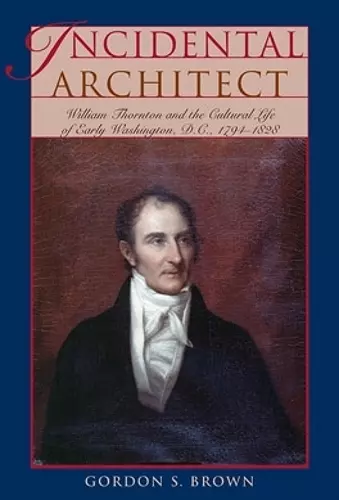Incidental Architect
William Thornton and the Cultural Life of Early Washington, D.C., 1794–1828
Format:Hardback
Publisher:Ohio University Press
Published:19th May '09
Currently unavailable, and unfortunately no date known when it will be back
This hardback is available in another edition too:
- Paperback£25.99(9780821418635)

While the majority of scholarship on early Washington focuses on its political and physical development, in Incidental Architect Gordon S. Brown describes the intellectual and social scene of the 1790s and early 1800s through the lives of a prominent couple whose cultural aspirations served as both model and mirror for the city’s own.When
While the majority of scholarship on early Washington focuses on its political and physical development, in Incidental Architect Gordon S. Brown describes the intellectual and social scene of the 1790s and early 1800s through the lives of a prominent couple whose cultural aspirations served as both model and mirror for the city’s own.
When William and Anna Maria Thornton arrived in Washington, D.C., in 1794, the new nation’s capital was little more than a raw village. The Edinburgh–educated Thornton and his accomplished wife brought with them the values of the Scottish Enlightenment, an enthusiasm for the arts, and a polished urbanity that was lacking in the little city emerging from the swamps along the Potomac. Thornton’s talents were manifold: He is perhaps best known as the original architect of the Capitol building, but he also served as a city commissioner and as director of the Patent Office, where his own experimentation in steam navigation embroiled him in a long-running dispute with inventor Robert Fulton.
In spite of their general preoccupation with politics and real estate development, Washington’s citizens gradually created a network of cultural institutions—theaters, libraries and booksellers, music venues, churches, schools, and even colleges and intellectual associations—that began to satisfy their aspirations.
Incidental Architect is a fascinating account of how the city’s cultural and social institutions were shaped by its earliest citizens.
“At a 1962 Nobel Prize dinner President John F. Kennedy famously remarked that his guests constituted the greatest gathering of knowledge at the White House since Thomas Jefferson dined alone. He might have said, since Thomas Jefferson dined with William Thornton. Anyway, that is the impression one gets from Gordon S. Brown’s convincingly argued and gracefully written account of early Washington, D.C., and one of its most memorable residents.” * The Journal of Southern History *
ISBN: 9780821418628
Dimensions: unknown
Weight: unknown
192 pages